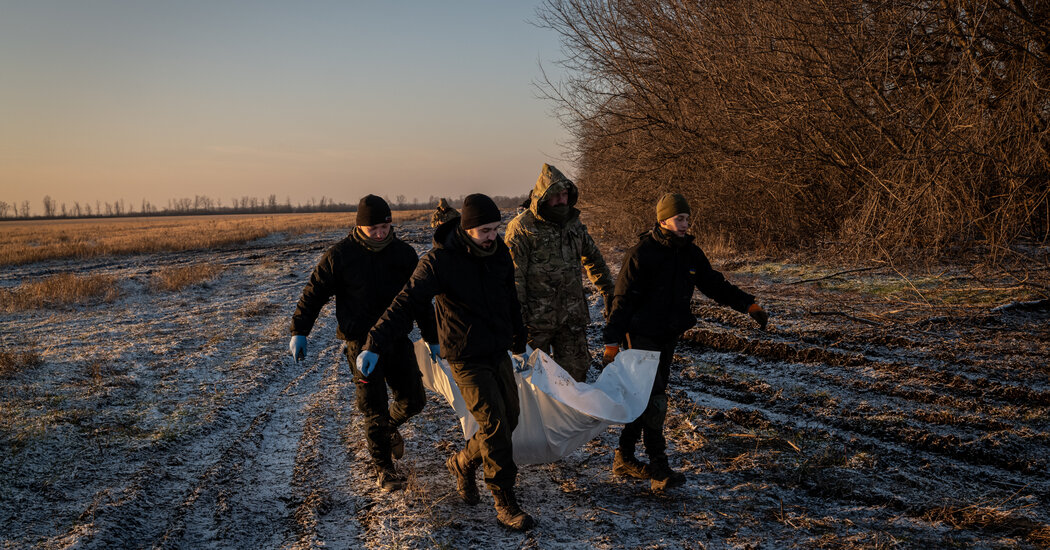The depth of the infighting inside the Russian government appears broader and deeper than previously understood, judging from a newly discovered cache of classified intelligence documents that has been leaked online.
The additional documents, which did not surface in a 53-page set that came to wide public attention online last week, paint a picture of the Russian government feuding over the count of the dead and wounded in the Ukraine war, with the domestic intelligence agency accusing the military of obscuring the scale of casualties that Russia has suffered.
The new batch, which contains 27 pages, reinforces how deeply American spy agencies have penetrated nearly every aspect of the Russian intelligence apparatus and military command structure. It also shows that the breach of American intelligence agencies could contain far more material than previously understood.
In one document, American intelligence officials say that Russia’s main domestic intelligence agency, the Federal Security Service, or F.S.B., has “accused” the country’s Defense Ministry “of obfuscating Russian casualties in Ukraine.” The finding highlights “the continuing reluctance of military officials to convey bad news up the chain of command,” they say.
The entry, dated Feb. 28 in a document with a series of updates about the war in Ukraine and other global hot spots, appears to be based on electronic intercepts collected by American intelligence agencies.
Each disclosure of classified documents has the potential to reveal additional methods and means of intelligence gathering. The documents do not appear to contain much, if any, information from human sources, suggesting the original leaker may not have had access to that more highly classified material. Instead, much of the material is labeled as coming from communications intercepts.
Taken together, the documents underscore several of the overarching reasons why, many analysts believe, President Vladimir V. Putin of Russia has failed to secure a military victory in Ukraine after more than 13 months of war.
Among them: infighting and finger-pointing among Russian agencies responsible for different aspects of the war, including the F.S.B. and the Defense Ministry. The leaked entry about the casualty numbers provides little context for the intelligence officials’ finding, but it reports that the F.S.B. is questioning the Defense Ministry’s own casualty count in discussions within the Russian government.
F.S.B. officials, the document says, contend that the ministry’s toll did not include the dead and wounded among the Russian National Guard, the Wagner mercenary force or fighters fielded by Ramzan Kadyrov, the strongman leader of the southern Russian republic of Chechnya. The sundry fighting forces that the Kremlin has deployed in Ukraine have sometimes acted at cross purposes, further complicating Russia’s military effort.
The F.S.B. “calculated the actual number of Russians wounded and killed in action was closer to 110,000,” the document says.
A Guide to the Leaked Pentagon Documents
A major intelligence breach. After U.S. intelligence documents, some marked “top secret,” were found circulating on social media, questions remain about how dozens of pages from Pentagon briefings became public and how much to believe them. Here is what we know:
The document does not specify the casualty figures that the Defense Ministry is circulating within the government. The last time that the ministry publicly disclosed a death toll was in September, when the defense minister, Sergei K. Shoigu, said that 5,937 Russian troops had been killed since the war started.
American officials have previously estimated Russian losses at about 200,000 soldiers. Another leaked document reports the Russians had suffered 189,500 to 223,000 casualties as of February, including up to 43,000 killed in action, compared with 124,500 to 131,000 Ukrainian casualties, with up to 17,500 killed in action.
The new documents also provide fresh details about a very public dispute in February in which Yevgeny V. Prigozhin, the business mogul who runs the Wagner force, accused Russian military officials of withholding urgently needed ammunition from his fighters. Mr. Putin attempted to resolve the dispute personally by calling Mr. Prigozhin and Mr. Shoigu into a meeting believed to have taken place on Feb. 22, one document reports.
“The meeting almost certainly concerned, at least in part, Prigozhin’s public accusations and resulting tension with Shoygu,” the document says, using an alternative transliteration of the minister’s name.
The new documents were shared in photos, and some are missing pages. Those shown in full include material from the National Security Agency, the Office of the Director of National Intelligence and the Pentagon’s Joint Staff intelligence directorate.
The material provided to The New York Times was posted on one of the Discord servers where the first set of Pentagon intelligence documents eventually appeared. U.S. officials have said those documents were authentic but cautioned that some had been altered. The documents may also contain outdated or inaccurate information.
The Times described the new batch of documents to multiple U.S. officials. While the officials did not dispute the information, they said they could not, and would not, independently verify the documents.
One slide that appears to have been produced by the military’s Joint Staff and dated Feb. 23 concludes that Russia has failed to disrupt the massive flow of Western arms and equipment into Ukraine since the start of the war, and asserts that the Kremlin’s battered military will not be able to change that anytime soon.
“During the next 6 months, Russia’s economic challenges and degraded conventional capabilities very likely will further impede its efforts, creating a mostly permissive environment for continued lethal aid deliveries,” the document said.
The Leak of Secret U.S. Military Documents
Many questions remain after a trove of classified Pentagon material was exposed on social media.
- Consequences: The leaked documents aren’t just an embarrassment for the Pentagon. American officials are worried that the breach could damage U.S. operations around the world.
- Containing the Fallout: Biden administration officials sought to calm anger in foreign countries over the leak but offered little new information about the source of the breach or its motive.
- The Investigation: A large number of people had potential access to the classified material. Clues left online may help investigators narrow down the pool of suspects.
- ‘Wild Card’ Scenarios: A leaked document outlines how the Russia-Ukraine conflict could be affected by four hypothetical events, including the deaths of Presidents Vladimir Putin and Volodymyr Zelensky.
The new material also includes a six-page document dated Feb. 23 from the Office of the Director of National Intelligence called “the Watch Report.”
Rather than finished intelligence conclusions, the Watch Report compiles various accounts that have come into intelligence agencies in the hours before it is distributed, some of them from single sources, often without in-depth context.
Government officials reading the Watch Report know that some of the materials will be proven correct, but other information, in time, will be shown to be incomplete, according to former officials.
For example, the Watch Report says Russian foreign intelligence “reported” that China had approved giving lethal aid to Russia, citing a communications intercept. It is not clear from the document if the Chinese had told the Russians they were sending the aid, or if the Russians were spying on the Chinese.
On March 3, a few days after the Watch Report document circulated within the U.S. government, NBC News reported, and The Times confirmed, that what the U.S. had learned about the plan to obtain lethal aid from China was “gleaned from Russian officials.”
But a senior administration official cautioned on Wednesday that weeks later, there is no indication that China has decided to give lethal aid to Russia, which suggests at the very least that Russian intelligence about Chinese intentions may be flawed.
Eric Schmitt contributed reporting.
















Leave a Reply